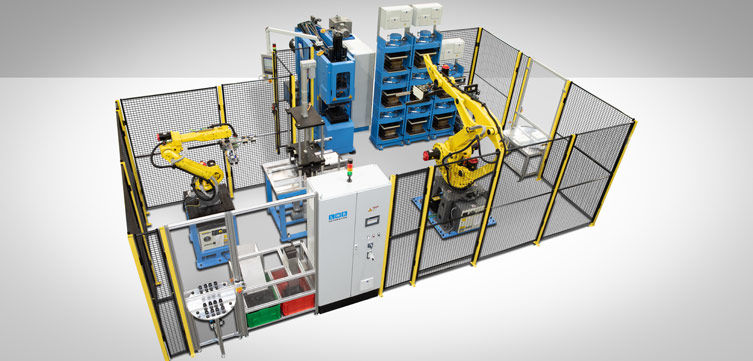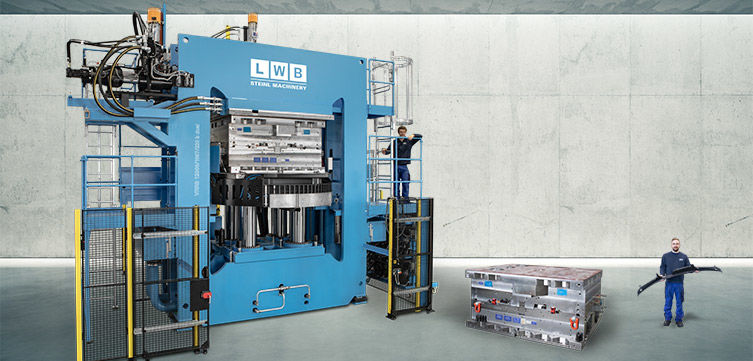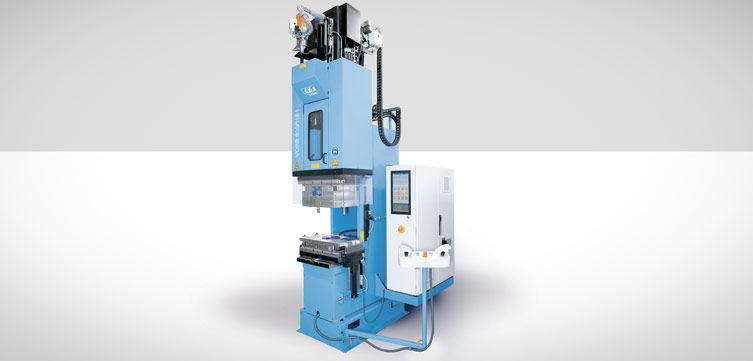At K- we have presented the latest version of our highly flexible multi-station elastomer injection molding system, which has already attracted great interest at DKT-2022. Other topics were an innovative large-scale machine technology, in particular its application advantages for the production of large multi-component moldings, and the latest C-frame vertical machine featuring an updated version of the flexEVO machine control.
The central exhibit of the LWB Group in Hall 14 / Booth A 68 was the current version of the "Multi-station Injection Molding System", which was first introduced in 2019. In contrast to the traditional "all-in-one" injection molding machine, it is a modular system combining one or more, usually smaller, vertical injection molding machines with separate heating / cooling or postprocessing stations. Within the system, just cavity plates instead of complete molds are transferred, by means of one or more industrial robots in a circuit between the system modules. This allows for running heating or cooling times in parallel to the machine, freeing up capacity in the machine for additional injection cycles. The central idea is to offer the user a production system that can work with the same (small) mold size from the prototype phase to series production. This is possible by increasing the number of cavity plates in circulation, geared by the demand. The number of cavity plate-sets is limited by the balance between the maximum possible injection cycles of the machine and the heating or cooling times of the cavity sets, including the transfer times. This makes the multi-station system an alternative to the traditional all-in-one-machine, which would at project start have to be combined a multi-cavity mold already designed for subsequent series production.

However, the LWB multi-station concept not only offers advantages when ramping up production numbers, but also when call-off quantities decrease. This is because, conversely, individual exchangeable mold sets can in stages also be taken out of circulation and the free capacity replenished with similar moldings. Another advantage of the step-by-step adaptation to production requirements is that, unlike a poorly utilized conventional multi-cavity production cell, the system always consumes only as much energy as corresponds with the smaller production quantity.
The multi-station system is available in combination with almost all vertical machines from LWB. A configuration example has been shown in operation at the booth.
LWB Steinl, one of the leading suppliers of vertical machines for processing elastomer materials, has in recent years increasingly established itself in the sector of vertical machines for thermoplastics. Here in particular with the LWB-specific VR (vertical/frame) series. It occupies a special position between the tie-bar-less C-frame machines and the conventional tie-bar machines. VR machines are also tie-bar-less, but the structures for absorbing the clamping force are thick-plate steel frame elements. Their dimensions can be flexibly adapted to the individual task at hand without being restricted by predefined casting components.

The potential of the concept is demonstrated by a virtual demonstration at the booth of a 2-injection-unit-machine with a horizontal rotary table with a diameter of 2.7 m, which can accommodate molds up to 27 t weight with platen sizes in the range of up to 2.2 x 1.6 m or 2.0 x 1.8 m. Due to the horizontal rotary table and the vertical introduction of the clamping force via four balanced pressure pads, the LWB-concept is superior to conventional horizontal machines with vertical rotary tables because no unilateral weight influences have a wear-promoting effect on the rotary table bearings and the rotary media unions.
Additional advantages of the VR-concept are the easily accessible injection units on top of the gantry frame modules, as well as the significantly smaller footprint compared to conventional horizontal machines. Another advantage is the unobstructed access to the product area in the injection mold which is at a low height above floor level, which means that a standard robot positioned next to the machine is sufficient for part manipulation.
The second Live-exhibit was a vertical C-frame machine with 500 kN clamping force, demonstrating the processing of a natural fiber-reinforced bio-based thermoplastic material from Biofibre GmbH (part of the LWB-group). The machine shown was equipped with the latest version of the flexEVO-control, which offers further networking possibilities within a digital production infrastructure.

Vertical LWB C-frame machine with the latest version of the flexEVO machine control. The C-frame-specific good accessibility of the mold area, qualifies it specifically for over-molding inserts or for the assembly of profiles.
Technical Details
Peter Radosai – Sales manager Europa
E-mail: peter.radosai@lwb.de.com
Press Contact
Christina Maniera – Marketing
E-Mail: christina.maniera@lwb.de.com
Author:
Reinhard Bauer – TECHNOKOMM
E-Mail: office@technokomm.at